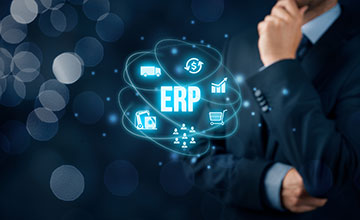During the last decade, the Enterprise Resource Planning systems, aka ERPs, have become an integral part of many businesses. Today they are used for all business purposes, including accounting, inventory, logistics, production, sales and marketing, and much more. Let’s see in detail what ERPs are, how they work, and how having one can benefit an organization.
What is ERP?
Although ERP is a rather a simple abbreviation, it has over several dozen definitions. Still, most of them share much in common, describing an ERP as a central database, shared and accessible by all company’s employees, and including software to provide for data access, processing, and storage.
For example, an ERP in retail helps to reflect the same items and prices across the chain, control shared inventory, provide for integration with e-commerce as well as deliver sales and finance analytics. An ERP for manufacturing helps to control the production of all product lines, forecast demand for supplies, and provide immediate access to sales and marketing teams to check availability among hundreds of other applications.
How Does an ERP System Work?
ERP replaces individual databases and spreadsheets, glues them together, and unifies the data flow, providing a bird’ s-eye view of all activities and data flow within the company.
It is built around a central database and includes several modules that share this database while interacting with each other. The modules are applications designed to meet the specific needs of each business or department. They may have individual interfaces and include tools and algorithms to enhance information processing and analytics.
What are the benefits of using an ERP?
- Real-time oversight of business activities on all levels. The overview, provided by having a centralized data system, creates an opportunity to visualize a business as a whole, analyze it from various perspectives, make predictions, and manage the risks. The technologies behind modern ERPs make these tasks even more simple by automating information processing, providing ready algorithms, and report templates.
- Cross-functional collaboration. ERPs make the integration between departments or branches a simple task, unifying data and formats, decreasing time for reconciling various reports and costs.
- Automation of processes and reporting. Unification of data, report templates, and availability of data processing algorithms based on best practices allow for automation of data management and reporting. These features enable companies to concentrate on their main business, cutting the need for resources needed to run the back office.
- Data safety and security. Since today most transaction processing is going digital, the importance of data security becomes even more apparent. Companies have to comply with international and local regulations as to the confidentiality of data provided by their clients, vendors, and other actors. ERP systems are built around the security principles eliminating chances for data leaks, non-compliance, and costly settlements in courts.
- New technologies. Today’s Enterprise Resource Planning systems are much more than a simple set of unified spreadsheets or a central database. They include applications and tools for business prediction and risk management as well as modern technologies such as AI (artificial intelligence), virtual assistants, and other advancements that not only bring the data management to an entirely new level but also create opportunities, decreasing risks and costs.
- Regular updates. Modern cloud-based ERPs receive regular updates made by teams of experienced developers and experts. ERP professionals analyze the best business practices and evolving needs and implement changes that are targeted to meet these needs in the most efficient way.
- No need to run in-house servers or develop software. Unlike older databases that required a company server, new ERPs can run entirely in the cloud and can be accessed from laptops and mobile.
Types of ERP Systems
ERPs can be classified by industry and by the implementation.
Examples of ERP classification by industry include production, educational, construction, retail, and other types of ERPs. Their differences are dictated by industry needs and specifics for a particular interface, data flow, and statistics.
ERP by implementation can be cloud-based, on-site, or hybrid.
- As suggested by its name, cloud-based ERPs are hosted by the provider who is responsible for the system’s maintenance and upgrades. This is one of the most widespread types of ERP, utilized by all types of businesses of various sizes. Cloud-based ERPs can be simple and include just a few functions such as invoicing and financial reporting, or more complex, including more modules and functions such as risk management and analytics.
- On-site ERPs are installed on the customer’s premises in an in-house data center. These provide more independence and flexibility but require having more IT staff, buying and maintaining their own hardware and software. Most often, such ERPs are employed by bigger companies with large operations who want to be autonomous and prefer to keep all their data management in-house for various reasons.
- Hybrid or two-tier EPRs are the mixture of the previous two and leverage the benefits of both of them while being less demanding on the recourses than on-site ERPs. Hybrid EPRs allow keeping a part of data management in the cloud, leaving certain modules in-house.
When Should You Start Seriously Considering an ERP System?
In the modern business environment, any company can benefit from having an ERP system starting from the early stages of its development. Indeed, managing the data and business processes through and ERP from the very start relieves from the need of costly and timely transfers of data at the later stages.
The typical signs that a company can benefit from utilizing some type of ERP system for its operation and move from spreadsheets to more effective management tools include:
- Rapid expansion. Those organizations which undergo a rapid expansion experience an enormous need for structuring their data and unifying the data flow in all the branches and subsidiaries. It can be one of the best moments to utilize a modern ERP system across the company, bringing the business to a new level.
- Data entering is manual, redundant, and not effective. When the company processes a large pool of data that are entered from various locations in various forms without observing a single standard, the information is often duplicated and becomes hard to use and navigate. The ERP can change that by cutting redundancy of information and standardizing data input across the company.
- Reports take too much time and get obsolete even before they are complete. Manual analytics takes an enormous amount of time, which makes it not fully up-to-date when ready as the situation can be changing every hour and even every minute. ERP would change the game, providing instant analytics in real-time at-a-click.
- Management lacks the whole picture. When the decision-makers start to feel that they are can’t visualize all the processes running at various levels and sectors of the company, an ERP system can become handy by providing necessary analytics and instant oversight into the data of any department.
- Important deadlines are missed, the production stumbles. When each department is relying too much on its own calendaring, and the oversight is lacking, the critical deadlines start to be missed, contracts not renewed in time, and sales figures drop. An ERP system includes forecasting tools and analytics providing timely reminders and statistics to make sure the company is on track.
- Collaboration between departments or employees needs improvement. When employees working in various sectors start to lack the important data, spend more time for getting and submitting various bits of information, and lack interaction, it’s a serious sign that something is wrong with the data management. Actually, this means that the EPR should have already been in place a long time ago, but it’s never late to have one.
- Remote access to any company’s data. When sales personnel needs to access the inventory instantly when on call with important customer, a regional manager needs instant oversight into branch business without an on-site visit, or when transactions are done on the go from mobile, the company is in need of cloud-based ERP.
- Data security concerns and compliance. When a company processes information from customers or suppliers, it has to comply with international and national standards as to data safety and security. Keeping such information in spreadsheets means the data are open to hackers’ attacks. Meanwhile, encrypting and protecting these data in-house may require running complex algorithms and processes. Moving to an EPR would settle all these concerns as modern Enterprise Planning Resource systems are built around security principles, including encryption of critical data.
- Increased costs of old ERP alternative. When the costs of maintaining the company’s old system rise, the operation may benefit from upgrading to a new-generation ERP with advanced technology, analytic tools, and software. The investment will pay off quickly as the company will be able to outsource most of the ERP upkeep and get regular updates.
Summing it Up
Previously used primarily by large corporations, ERPs have become an integral part of modern businesses who strive to be ahead of the time through innovation and use all the benefits of modern technology and tools for effective project management. Started as systems to account for inventory on large production facilities, today ERPs are used by various companies in all types of business settings.
No matter the size of the company, each business can benefit from utilizing an ERP from the very early stage of its development. Having an Enterprise Resource Planning system in place would allow having all the data in a standardized format, utilize a predetermined set of forms and reports without the need to invent ones, access all company information from any location and platform, and provide for data safety and compliance.
There is a number of ERPs for any purpose, including billing and accounting, production, logistics, HR, education, and others. The ERPs can be fully cloud-based, on-site, or hybrid. But whatever their type, all of them are based on the common principle that all data should be centralized, standardized, and instantly accessible. All companies can benefit from optimization and automation provided by ERPs, saving time and costs, and releasing resources to concentrate on creativity and business-critical matters.




